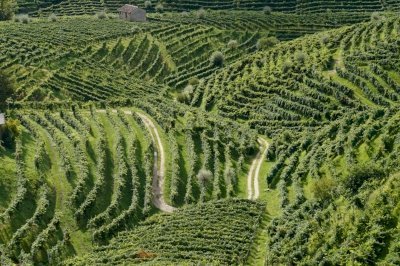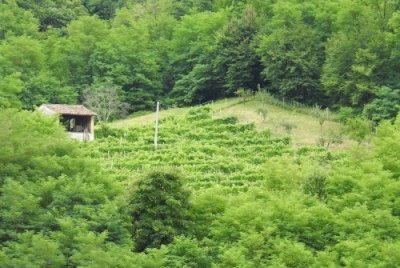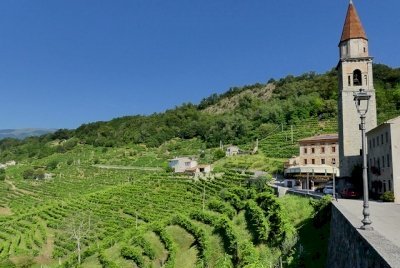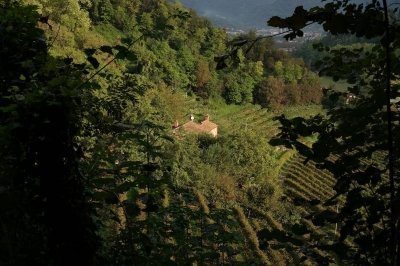Italy
The Prosecco Hills
Le Colline del Prosecco di Conegliano e Valdobbiadene form a viticultural landscape in challenging, mountainous terrain.
The highest quality Prosecco, an extra dry sparkling white wine, has been produced here since the 18th century. The vineyards had to be managed on steep slopes; it was done by using grassy terraces (ciglioni) and applying the bellussera method to get the maximum out of the lands.
Community Perspective: We can count on Clyde and Hubert to seriously investigate these sparkling white wines. They both named Rolle as the best place to see the steep terraces.
Site Info
Official Information
- Full Name
- Le Colline del Prosecco di Conegliano e Valdobbiadene (ID: 1571)
- Country
- Italy
- Status
-
Inscribed 2019
Site history
History of The Prosecco Hills
- 2019: Inscribed
- Inscribed
- 2018: Advisory Body overruled
- ICOMOS advised Not to inscribe; amendment to Inscribe voted against 9-12 in secret ballot (no 2/3 majority). Finally overturned to a Referral after much debate, including a Deferral amendment lead by Australia.
- 2018: Referred
- Type
- Cultural
- Criteria
- v
Links
- UNESCO
- whc.unesco.org
- Official
-
- collineconeglianovaldobbiadene.it — The Prosecco Hills of Conegliano and Valdobbiadene
All Links
UNESCO.org
- whc.unesco.org — whc.unesco.org/
Official Website
- collineconeglianovaldobbiadene.it — The Prosecco Hills of Conegliano and Valdobbiadene
Community Information
- Community Category
- Cultural Landscape: Continuing
Travel Information
Veneto hotspot
Recent Connections
-
Untranslated Toponyms
The official name is "Le Colline del Pr… -
Innovations in Agriculture
- "Until 1874 the traditional training … -
Veneto hotspot
Trains run quite regularly from Venice …
Connections of The Prosecco Hills
- History
-
-
Republic of Venice
"The Venetian rule of the Veneto hinterland from the 14th century to the 18th was a form of land government by the Republic of Venice, and produced the original structure of the nominated territory's agricultural layout through a profound reorganization of the road network and the introduction of more modern agricultural techniques." (Nomination file, p. 41)
-
- Architecture
-
-
Vernacular architecture
"The rural cottage (...) is more commonly found in the core zone. It does not reflect established formal canons but is often a sum of various parts developed over time mirroring the fortunes of the owner family. (...) In terms of materials, local stone, due to its extreme variability, is the most distinctive identifying feature of these buildings. Clustered settlements and isolated houses are an important part of the local landscape: having been abandoned and underutilized, they are wholly preserved, and are still today used to fulfill agricultural functions, or are often converted into cellars." (Nomination file, p. 46)
-
- World Heritage Process
-
-
Inscribed on a single criterion only
Crit v -
Reduced from broader TWHS
Conegliano including the viticulture school were omitted
-
- Human Activity
-
-
Vineyards
Of the Prosecco wine production area -
Man-made Terraces
"In the nominated property a peculiar form of terracing called "ciglioni" was chosen. They respond to the same need to create a flat surface on which cultivating is possible, but with a very unusual technique using grass instead of dry stone walls, as is more popular in most regions." (Nomination file, p. 86) -
Irrigation and drainage
"The construction of ciglioni required not only to shape the slopes creating a terrace, but also to facilitate water drainage, excavating a ditch on the upper part of the terraces, at the foot of the wall of the terrace immediately above." (Nomination file, p. 87, 101)
-
- Timeline
-
-
Built in the 18th century
The earliest documentation concerning the cultivation of the Glera grape variety in the Veneto region dates back to 1754. (AB ev)
-
- WHS Hotspots
-
-
Veneto hotspot
Trains run quite regularly from Venice and only take an hour to Conegliano which should leave enough time to enter core zone.
-
- Science and Technology
-
-
Innovations in Agriculture
- "Until 1874 the traditional training method applied in the vineyards of the low hills and plains was almost entirely made of rows of vines raised up high and eventually tied up to a tree, while the spaces between the rows where cultivated with cereals or other crops. (...) In the 19th century the system started to be criticized because of the competition between the species for water and nutritional elements, the difficulties connected with the soil working and the unsatisfactory quality of the grapes obtained. Under these circumstances, we see the invention of a new and original system, the bellussera, as a response by the local farmers to the need of developing new viticulture techniques." – "Another site-specific agricultural technique is the "bellussera", an original and unique training method invented in the DOCG area in 1880, by the Bellussi family." (Nomination file, p. 68-69, 101)
-
- WHS Names
-
-
Untranslated Toponyms
The official name is "Le Colline del Prosecco di Conegliano e Valdobbiadene". "Colline" means "hills" in Italian.
-
News
No news.
Recent Visitors
Visitors of The Prosecco Hills
- Adrian Turtschi
- AK
- Alberto Rodriguez Gutierrez
- Alexander Barabanov
- Alexander Lehmann
- Ammon Watkins
- Ana Lozano
- Argo
- Atila Ege
- Bin
- Carlos Sotelo
- Cezar Grozavu
- Cheryl
- Christian Wagner
- christof
- Christoph
- Clyde
- Csaba Nováczky
- CugelVance
- Daniel Chazad
- Dan Pettigrew
- David Berlanda
- Deffra
- Dimitar Krastev
- Dorejd
- Dwight Zehuan Xiao
- Elia Vettorato
- Els Slots
- Errol Neo
- Federico P.
- Feldhase
- Frédéric M
- Frederik Dawson
- FS
- Harry Mitsidis
- Hasco
- henrik_hannfors
- Hubert
- Iain Jackson
- Ivan Rucek
- Jakob F.
- Jana and Matt
- Janina Lehmann
- Janos
- Jan-Willem
- Jarek Pokrzywnicki
- Jasam
- Jeanne OGrady
- Jeffrey Chai
- Jesse S 2010
- Jezza
- JobStopar
- Jonas Kremer
- KarenBMoore
- Kbecq
- kjluebke
- La Concy
- Lara Adler
- lindaann
- Lisu Marian
- Loic Pedras
- Luboang
- Lucio
- Luis Filipe Gaspar
- Maciej Gil
- Martina Rúčková
- Mateusz
- mg:1
- MH
- MichaelH
- Mihai Dascalu
- Monica Tasciotti
- Mtlmr
- nan
- Nihal Ege
- PabloNorte
- Patrik
- Peltzi
- Petteri
- Philipp Leu
- Philipp Peterer
- Piotr Wasil
- Porcho
- Rafał Kałczuga
- Ralf Regele
- Randi Thomsen
- Reiseblitz
- Riccardo Quaranta
- Rick Ohm
- RobRos
- Roel Sterken
- Roger Ourset
- Roman Bruehwiler
- Roman Raab
- Rudegirl
- Solivagant
- Stanislaw Warwas
- stephanvermeulen
- Stijn
- Svein Elias
- Szabolcs Mosonyi
- Szucs Tamas
- Tamara Ratz
- Taotao Chen
- Tarquinio_Superbo
- Thomas Buechler
- Thomas van der Walt
- Tim Allen
- Tinamu
- tony0001
- triath
- Tsunami
- vino4vino
- WalGra
- WILLIAM RICH
- Wimmy
- Wojciech Fedoruk
- Yevhen Ivanovych
- Zoë Sheng
Community Reviews
Show full reviews
Oh no, not another vineyard. That was my first thought when the Prosecco Hills were inscribed on the World Heritage list in 2019. Not really an enthusiastic reaction. But is it justified? Well, vineyards are an over-represented category. But we are in Italy, so good food can be expected and I can taste a wine I didn't know well before. Reasons enough to spend a long weekend in the Veneto and tick off a new WHS. So in September 2021, I set off on a 5-hour drive to the Prosecco Hills.
The inscription was highly controversial, a secret ballot was needed to overrule the "not inscribe" recommendation by ICOMOS in 2018. One year later, an amended proposal with a significantly reduced core zone was inscribed. The focus is on the scenic landscape with its steep vineyards and small hilltop villages. The production sites and wine cellars are not explicitly mentioned in the description and obviously do not contribute to the OUV of the site. In this respect, the Prosecco Hills differs, for example, from the French "Champagne Hillsides, Houses and Cellars". The larger villages at the foot of the steep hills are not included, nor are the eponymous towns of Conegliano and Valdobbiadene. And rightly so, the cultural heritage here - historic town centres, churches and monasteries - is not outstanding and is below the level of other World Heritage sites in Italy.
I got a first impression of what is special about the Prosecco hills when I …
Keep reading 0 comments
I was badly in need of a weekend trip to Italy after 1.5 years of drought on that usually enjoyable travel front. I had hoped for a positive evaluation of Bologna for the 2020/2021 WHC session, as the university city itself appealed to me (the Porticoes not so much). But that wasn’t the case and I turned instead to the Prosecco Hills, my last remaining ‘tick’ in Italy. The Prosecco Hills lie in the foothills of the Alps. So far up north, this isn’t the elegant, bright, artistic and life-loving Italy anymore. It’s more like an Austrian/German farmers’ region, with the restaurant menu heavy on game meat.
I stayed overnight in the city of Vittorio Veneto, easy to reach by train from Venice. It lies directly to the northeast of the inscribed area of the Prosecco Hills. Which leads me to point out the terrible quality of the map belonging to this WHS. Only when you zoom in to the max and have great eyes, you’ll know what is inscribed and what isn’t.
For my WHS visit I took a bus to Follina, some 25km further along road SP635/SP4 a.k.a. the “Strada del Prosecco”. Bus 117 leaves Vittorio Veneto every 1.5 – 2 hours daily. I got out in the town center. Follina has a few picturesque old houses and a large basilica, which is being restored at the moment. This town as well as all the others of a size above a rural village are excluded from …
Keep reading 0 comments
I visited this WHS in July 2019 on a whim to keep Italy complete. As such it will always have a special place in my memories as I was listening to its inscription on the WH list in my car, literally while reaching Valdobbiadene. Having visited what in my opinion are Italy's best vineyard WHS, famed for its red wines, we didn't mind heading to Valdobbiadene-Conegliano after Cannelli/Asti to taste more of Italy's sparkling white wines.
The valley between Valdobbiadene and Conegliano is covered with vineyards and dotted with small villages (not comparable to the ones in Piedmont). I used a local winegrower's B&B near Valdobbiadene as my base for 3 days where I learnt that the best category of Valdobbiadene-Conegliano prosecco comes from the Cartizze area, at the foot of the Cesen mountain (1570m - nice panoramic view for sunset). The Cartizze area has an ideal microclimate which gives the best expression to the Glera grapes and hence the special organoleptic characteristics of prosecco's 'Grand Cru'. This is mainly thanks to its sun exposition, its ventilation, its soil and its temperature variation. The Cartizze valley hills rise from 200 metres to 350 metres above sea level. The steep hills are facing south, meaning that virtually every vine is always exposed to sunlight and is never affected by the shadow of the vines in front, giving the grapes the opportunity to mature evenly and with a higher sugar content than in any other prosecco production area. Moreover, there's a …
Keep reading 0 comments
One of the charms (or challenges) of visiting tentative sites is that the usual tourist infrastructure is missing. No visitor center, no heritage trails, little to no signposting, no official website ... And worse, as it’s still a nomination neither the boundaries nor locations are finalized. So I was left wondering what the proposed site "Prosecco Hills of Conegliano and Valdobbiadene" entailed and what to visit. I found the nomination to be rather unhelpful in that respect.
One site that is mentioned and that can be visited easily is the Convitto Scuola Enologica in Conegliano. It is based in a 19th-century manor on the outskirts of town and supports to this day the local vineyards in growing the Glera grape.
From there you can travel onward into the main hills between Conegliano and Valdobbiadene. I googled a bit and found a trail in Premaor, more or less in the middle of the region. So I hopped on a bus and went on a hike in the hills. The trail was poorly signposted (see above) so I missed out on a Chateau along the way and had to walk back along the main road (not so nice). After 2h I decided to call it a day and headed back to Conegliano.
If the Piedmont Vineyards were the threshold, the Prosecco Hills should have been inscribed the first time around. The viticulture university offers actually some uniqueness. But I hope to have made abundantly clear in both …
Keep reading 0 comments